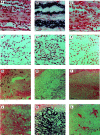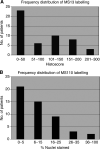A role for BRCA1 in sporadic breast cancer
- PMID: 12698194
- PMCID: PMC2747570
- DOI: 10.1038/sj.bjc.6600863
A role for BRCA1 in sporadic breast cancer
Abstract
To test the hypothesis that altered expression of BRCA1 protein may play an important role in sporadic breast cancer development, 50 randomly selected primary breast cancers (frozen sections, 5 years' median follow-up) were immunolabelled with two monoclonal BRCA1 antibodies (MS110 and MS13). MS110 labelling was exclusively nuclear showing no relation to outcome or tumour pathology. Western blotting demonstrated crossreactivity, suggesting antibody nonspecificity. MS13 labelling was predominantly cytoplasmic. Intense labelling predicted decreased overall survival (P=0.012), disease-free survival (P=0.029), oestrogen receptor negativity (P=0.0004) and c-erbB-2 overexpression (P=0.006). Western blotting detected a 110 kDa molecule consistent with BRCA1 delta11b splice variant. BRCA1 protein is postulated to function as a tumour suppressor. We demonstrate cytoplasmic localisation in sporadic breast cancer suggesting excess delta11b splice variant production, reduced production of full-length BRCA1 and thus postulate reduced tumour suppressor activity. BRCA1 protein appears to have a significant role in both sporadic and hereditary breast cancers.
Figures





Similar articles
-
BRCA1 expression and molecular alterations in familial breast cancer.Histol Histopathol. 2009 Jan;24(1):69-76. doi: 10.14670/HH-24.69. Histol Histopathol. 2009. PMID: 19012246
-
Promoter Hypermethylation and Expression Changes of BRCA1 Gene in a Cohort of Sporadic Breast Cancer Cases among Pakistani Population.Asian Pac J Cancer Prev. 2020 Aug 1;21(8):2395-2401. doi: 10.31557/APJCP.2020.21.8.2395. Asian Pac J Cancer Prev. 2020. PMID: 32856871 Free PMC article.
-
High frequency of HIF-1alpha overexpression in BRCA1 related breast cancer.Breast Cancer Res Treat. 2008 Oct;111(3):475-80. doi: 10.1007/s10549-007-9817-z. Epub 2007 Nov 21. Breast Cancer Res Treat. 2008. PMID: 18030615
-
Regulation of BRCA1 expression and its relationship to sporadic breast cancer.Breast Cancer Res. 2003;5(1):45-52. doi: 10.1186/bcr557. Epub 2002 Nov 13. Breast Cancer Res. 2003. PMID: 12559046 Free PMC article. Review.
-
BRCA1 in non-inherited breast carcinomas (Review).Oncol Rep. 2002 Nov-Dec;9(6):1329-33. Oncol Rep. 2002. PMID: 12375043 Review.
Cited by
-
Impact of Etoposide on BRCA1 Expression in Various Breast Cancer Cell Lines.Drugs R D. 2017 Dec;17(4):569-583. doi: 10.1007/s40268-017-0208-6. Drugs R D. 2017. PMID: 28879638 Free PMC article.
-
BRCA1 protein expression and subcellular localization in primary breast cancer: Automated digital microscopy analysis of tissue microarrays.PLoS One. 2017 Sep 1;12(9):e0184385. doi: 10.1371/journal.pone.0184385. eCollection 2017. PLoS One. 2017. PMID: 28863181 Free PMC article.
-
High BRCA1 gene expression increases the risk of early distant metastasis in ER+ breast cancers.Sci Rep. 2022 Jan 7;12(1):77. doi: 10.1038/s41598-021-03471-w. Sci Rep. 2022. PMID: 34996912 Free PMC article.
-
Phosphorylation of the androgen receptor is associated with reduced survival in hormone-refractory prostate cancer patients.Br J Cancer. 2008 Mar 25;98(6):1094-101. doi: 10.1038/sj.bjc.6604152. Epub 2008 Mar 18. Br J Cancer. 2008. PMID: 18349820 Free PMC article.
-
Unraveling the chromosome 17 patterns of FISH in interphase nuclei: an in-depth analysis of the HER2 amplicon and chromosome 17 centromere by karyotyping, FISH and M-FISH in breast cancer cells.BMC Cancer. 2014 Dec 7;14:922. doi: 10.1186/1471-2407-14-922. BMC Cancer. 2014. PMID: 25481507 Free PMC article.
References
-
- Anderson SE, Schlegel BP, Nakajima T, Wolpin ES, Parvin JD (1998) Brca1 protein is linked to the RNA polymerase II holoenzyme complex via RNA helicase A. Nat Genet 19: 254–256 - PubMed
-
- Bartlett J, Going J, Mallon E, Watters A, Reeves J, Stanton P, Richmond J, Donald D, Ferrier R, Cooke T (2001) Evaluating HER2 amplification and overexpression in breast cancer. J Pathol 195: 422–428 - PubMed
-
- Bland JM, Altman DG (1986) Statistical methods for assessing agreement between two methods of clinical measurement. Lancet i: 307–310 - PubMed
-
- Bland JM, Altman DG (1999) Measuring agreement in method comparison studies. Stat Methods Med Res 8: 135–160 - PubMed
-
- Bradford MM (1976) A rapid and sensitive method for the quantification of microgram quantities of protein utilising the principle of protein-dye binding. Analyt Biochem 72: 248–254 - PubMed
Publication types
MeSH terms
Substances
LinkOut - more resources
Full Text Sources
Medical
Research Materials
Miscellaneous

